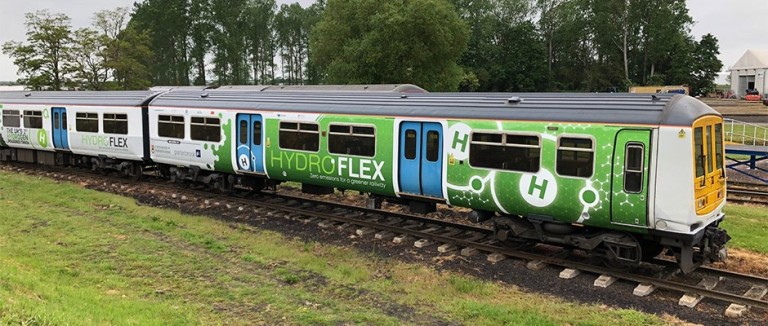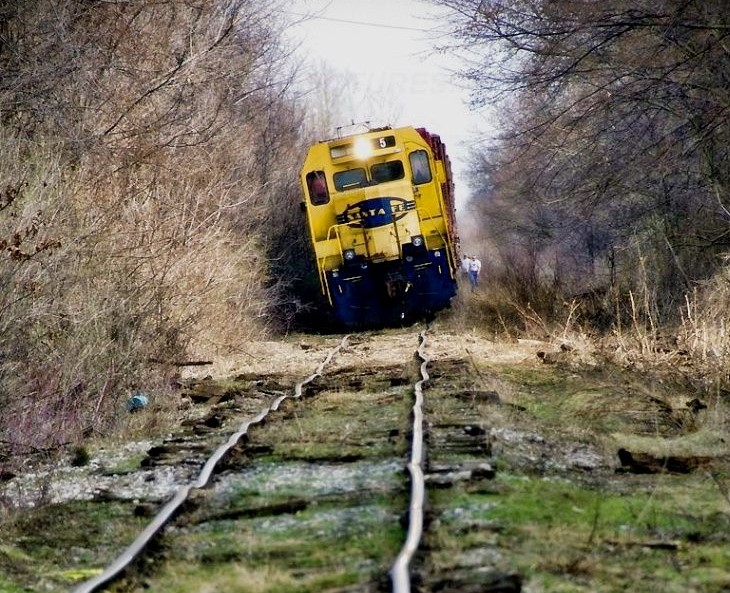👉 See also a full review of railway news on this page
01/25/2021 – By Frédéric de Kemmeter – Railway signalling
Suscribe my blog
Since 2018, hydrogen trains are in commercial operation in Germany and are being tested in the Netherlands, France and the UK. They are marketed as ‘green’ because the only emission they produce in operation is steam. No dirty pollution in our cities and in stations. This is exactly what our politicians were looking for to respond to the great climate movement of the moment. So they came up with the idea of producing this new miracle fuel wherever possible. Hydrogen has suddenly become the « flavour of the month. »
The excellent Roger Ford from Modern Railway reminded us of the famous Gartner cycle last March. Although subject to some academic criticism, this curve can be applied to any form of hype, of which communication specialists are so fans. What does this graph tell us? It shows that a potential technology breakthrough kicks thing off of a new hype and rapidly provoques a peak of Inflated Expectations. It was the case with autonomous vehicle. After what a trough of disillusionment is coming and interest wanes as experiments and implementations fail to deliver. Some startup of the technology shake out or fail. Then, a « slope of Enlightenment » gathers strength when the technology can become more widely understood and when suppliers offer better controlled products.
 (schema Jeremykemp via wikipedia)
(schema Jeremykemp via wikipedia)
Of what interest could that be with hydrogen? Simply because politicians have seized on this fuel to come up with major decarbonization plans. We are now at the « peak of Inflated Expectations » of the Gartner curve. Hydrogen is indeed being heralded as the critical link for transitioning the energy sector away from fossil fuels towards clean and renewable sources. As a result, countries and companies are investing heavily in research to make hydrogen commercially viable, especially within industries that are energy and pollution heavy.
There is now a communication battle between the diesel engine and hydrogen. Take Daimler, which in December 2020 signed a declaration with six other manufacturers to stop selling fossil-fueled vehicles by 2040. But on its website, Daimler argues that it is worthwhile to improve the diesel further rather than banning it. So what?
 Class 165/1 ‘Network Turbo’ 2-car dmu No.165 122 (with a 3-car Class 166 dmu No.166 208) of GWR Brunswick Green livery approaching Keynsham. Some high-traffic lines will have to receive the catenary at a later date (photo Hugh Llewelyn via license flickr)
Class 165/1 ‘Network Turbo’ 2-car dmu No.165 122 (with a 3-car Class 166 dmu No.166 208) of GWR Brunswick Green livery approaching Keynsham. Some high-traffic lines will have to receive the catenary at a later date (photo Hugh Llewelyn via license flickr)
This comparison with the diesel engine is of high importance for the railway sector, mainly in countries with a poorly electrified network. Trains in the UK still rely mainly on diesel traction – an estimated 62 per cent of the rail network is diesel-powered compared with 38 per cent electrification. In 2016-17 in the UK, the passenger railway emitted three million tons of CO2 equivalent. A Voyager trainset (Bombardier) making an Edinburgh to Plymouth return journey (2-time 790km), emits just over 10 tons of CO2. Despite these figures, rail contributes less than one per cent of the total UK annual greenhouse gas emissions. The urgency of the hydrogen train seems then rather vague, even though not everyone does to agree with this analysis. Especially since the question of its production arises, which is not in principle a railway problem.
Approximately 70 million metric tons of hydrogen are already produced globally every year for use in oil refining, ammonia production, steel manufacturing, chemical and fertilizer production, food processing, metallurgy, and more. The blue and grey hydrogen production is responsible for 830 million metric tons of CO2 emissions each year. This is far from negligible. Currently, green hydrogen – the sort needed to reach net zero by 2050 – represents less than 4% of all hydrogen produced. Ramping up production is necessary but costly, hampered by a host of technical challenges across the supply chain.
The supplier of both battery and fuel cell powered road vehicles, Scania cautions going forward the use of hydrogen for such applications will be limited since three times as much renewable electricity is needed to power a hydrogen truck compared to a battery electric truck. A great deal of energy is namely lost in the production, distribution and conversion back to electricity.
 The issue of hydrogen infrastructure…
The issue of hydrogen infrastructure…
The green production of hydrogen also raises many questions related to the quantity of wind farms, which cannot be extended indefinitely because of urban areas and opposition from local residents. There are also the places where the electrolysis will take place, as well as the pipelines that will bring the hydrogen to the refuelling stations, which are necessarily far from the wind farms. Because hydrogen is so much less dense than gasoline, it is difficult to transport. It either needs to be cooled to -253˚C to liquefy it, or it needs to be compressed to 700 times atmospheric pressure so it can be delivered as a compressed gas. Currently, hydrogen is transported through dedicated pipelines. All of this has a cost and may take time for planning permission. Moreover, the probable end of thermal motorisation by 2035 or 2040, depending on the source, would mean a huge fleet of electric cars to charge every day. Will there be a small place for rail electrolysis in this gigantic production, and at what price? Nothing is certain yet…
“A hydrogen-based energy transition will not happen overnight,” Irena’s report confirmed in 2019 (International Renewable Energy Agency). “The use of hydrogen will target specific applications. The need for a dedicated new supply infrastructure may limit his use.” We would therefore be at the bottom of the curve, in the trough of disillusionment…
Fuel cell traction is likely to have its place on lightly used lines where even the lowest cost electrification may not be viable. But it is a small part and this saving is minimal, compared of the full decarbonizing of railways. If one accepts this analysis, one can then find oneself in the upward curve, where the initial idea is updated by analysis of the cost/benefit figures. In 2021, we are still at the stage of a certain euphoria (the top of the Gartner curve), while it is known that wind energy is unstable depending on the weather and, moreover, highly dependent on public subsidies. There will come a time when the right questions will start to be asked…
 Mol-Hamont, Belgium: a 33km line which was electrified by Infrabel (photo Benjamin Brolet/Infrabel)
Mol-Hamont, Belgium: a 33km line which was electrified by Infrabel (photo Benjamin Brolet/Infrabel)
The conclusion that can reasonably be drawn is that traditional catenary electrification is – and will be – called upon to do most of the work of decarbonizing the railways. Hydrogen trains will be in the minority. In the UK, of the 9,855 kilometers of non-electrified lines, Network Rail would have estimated in September 2020 that only 900 kilometers would be eligible for hydrogen trains and another 400 for battery trains. The remainder of the non-electric lines would therefore have to be equipped with 25kV catenary systems. In France, an Ademe study seems bolder and has identified 34 lines likely to be compatible with hydrogen technology, but we are in the « Alstom country », which can mean many things… However, it is possible that hydrogen train mileage will be higher in the future if significant progress is made in electrolysis and in the supply prices of green fuel. This is still very difficult to estimate at present.
It is obvious that the calculation of electrification – or not – by catenary will vary greatly according to the policies pursued and the public finances available. The weight of the hydrogen lobby could play a more favorable role in some countries than in others and wind farms do not have the same density everywhere. By the end, rail policy will also play a role, in terms of whether to maintain small local lines at reasonable cost and what gain it will bring to the community.
So, is the hype around hydrogen justified? The answer is a yes, but the hype should be directed to the right market niche. Let’s not make hydrogen trains the new fashionable ideology, but let’s keep our sense of pragmatism to a maximum.
 Potůčky, border between Czech Republic and Germany. A business case for hydrogen ? (photo Ingolf Nistad via licence flickr)
Potůčky, border between Czech Republic and Germany. A business case for hydrogen ? (photo Ingolf Nistad via licence flickr)
Share this:
>>> Others news here
Suscribe by mail to connect with railway information
Related articles:
 More about the Gartner’s Hype Cycles
More about the Gartner’s Hype Cycles
Hype Cycles and Priority Matrices offer a snapshot of the relative market promotion and perceived value of innovations. They highlight overhyped areas, estimate when innovations and trends will reach maturity, and provide actionable advice to help organizations decide when to adopt.
 Europe calls for zero-emission transport by 2050. An opportunity for railways
Europe calls for zero-emission transport by 2050. An opportunity for railways
12/14/2020 – Europe presents its mobility strategy through ten measures, five of which concern the rail sector.
 Which future for hydrogen-propelled trains?
Which future for hydrogen-propelled trains?
02/08/2021 – Can hydrogen trains make it possible to avoid railway electrification? It all depends, and many questions remain to be answered. A brief overview
 Rebirth of Maglev for urban transports
Rebirth of Maglev for urban transports
11/30/2020 – It was thought that Europe was no longer interested in this technology, but one entrepreneur still believes in it. The German company Max Bögl has designed a Maglev for urban use in Asia.
 VLR, the comeback of little Railbuses
VLR, the comeback of little Railbuses
05/27/2020 – How can we respond to traffic on short lines where the criteria of conventional railways are too cumbersome and uneconomic? By returning to an old idea: the very-light railcar, close to the automobile world.
 Sustainable railways mean infrastructure works !
Sustainable railways mean infrastructure works !
11/16/2020 – 2021 has been designated European Year of Rail. This means not only modern trains but also good railway infrastructures. Some people believe that this is not always necessary. Really?
![]()

